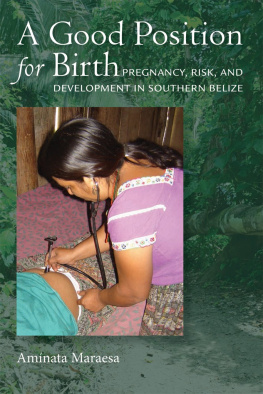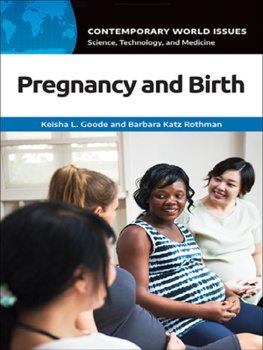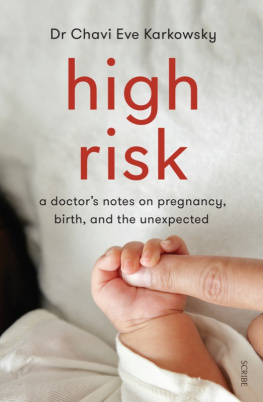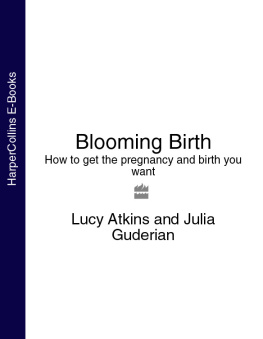A GOOD POSITION FOR BIRTH
A Good Position for Birth
PREGNANCY, RISK, AND DEVELOPMENT IN SOUTHERN BELIZE
Amnata Maraesa
Vanderbilt University Press
Nashville
2018 by Vanderbilt University Press
Nashville, Tennessee 37235
All rights reserved
First printing 2018
This book is printed on acid-free paper.
Manufactured in the United States of America
Library of Congress Cataloging-in-Publication Data on file
LC control number 2017044710
LC classification number RG963.B42 M37 2018
Dewey classification number 362.19820097282dc23
LC record available at lccn.loc.gov/2017044710
ISBN 9780-826522009 (cloth)
ISBN 9780-826522016 (paperback)
ISBN 9780-826522023 (ebook)
To Kennon Rodney and Miss Margaret Edwards, whose livesand deathshave altered my understanding of and relationship with Toledo. And for Afinatou, Safouane, and Douniya, because I love you infinity times pi times the oven you bake the pie in.
Contents
Figures and Tables
Figures
All photographs are by the author, except as noted.
Tables
Acknowledgments
I thank first and foremost the people in Belize who shared their time with me throughout my fieldwork and beyond. To protect their anonymity, I cannot identify individuals by name, but please know that I am grateful for your kindness and your offering of the sensitive and personal information that has contributed to this work on reproduction. I am forever indebted to Shanon Rodney for taking care of my children, taking care of me, and eventually including us in her household and extended family network. I must acknowledge the invaluable assistance of the Ministry of Health and the many officers and personnel who facilitated my quest for knowledge. I also wish to thank GIFT and its employees for opening their doors to my project and giving me an initial start in the field. Finally, I am deeply appreciative of the many individuals who assisted me over the internet (especially Mr. Marvin Moody and the Statistical Institute of Belize) in acquiring last-minute data from archival sources in Belize and Ruth McDonald for hospital logistics and data. Thank you to Santiago Shol and Eduardo Salam for their assistance with the Kekchi-English translations, Ignasi Clemente for Spanish help, and Tyrone Avila for Garifuna grammatical correctness.
I thank my academic interlocutors Connie Sutton, Aisha Khan, Emily Martin, Don Kulick, Ulla Dalum Berg, Jack Murphy, Lauren Fordyce, Alyshia Glvez, and Kristina Baines who provided continuous encouragement, advice, and critical reflection throughout. I especially thank Rayna Rapp for her unwavering support and confidence in my work and for looking out for me on countless occasions. And thank you Theodore Kirkland, Mark Payne, and Mohammad Hassan for your initial faith in me.
I am deeply appreciative of my many friends who maintained their belief in my madnesswithout your support this work would not exist (I love you Lynda, Sadiqa, Lat, and Nara). Brigitte et Daniel, je ny serais pas arrive sans vous. Nicole, my rock together young until we die. And Madala who was there literally from day one. But of course, Afinatou, Safouane, and Douniya: you never cease to exhibit incredible patience with a stressed-out mom. Thank you for allowing me to uproot you from the City and replant you in the bush. Life begins anew. I dream of fish. Aum Shanti.
Generous funding for various stages of this research and writing was provided by the Wenner Gren Foundation for Anthropological Research, the International Womens Anthropology Conference, and internal grants at New York University.
A heartfelt thank you to my editor, Michael Ames.
Portions of also appear in Maternal Health, Pregnancy-Related Morbidity, and Death among Indigenous Women of Mexico and Central America: An Anthropological, Epidemiological and Biomedical Approach, edited by David Schwartz and published by Springer (2018).
Introduction
Here we could have as many babies as we want. We no have no laws against that.
Comment I often heard from pregnant women at the prenatal clinics
Mr. Price say mek we build the nation!
Teodora, a thirty-eight-year-old Mopan Maya woman discussing pregnancy
It is early Wednesday morning, February 2006, in Punta Gorda, the only town in the southernmost Toledo district of Belize. The sea laps at the rocky coastline, hens shepherd their broods, and schoolchildren join their peers across the country as they stand to start the day with the national anthem. Most wear uniforms, although some do not have shoes, and all learn from a very young age to be proud citizens of this peaceful democratic nation located between Central American and Caribbean political unrest and economic instability. Strolling down the sidewalk and past the open-air classrooms are the many pregnant women who come to shop, visit friends, and attend the prenatal clinic at the town hospital. Some are accompanied by young children, and others must hurry home to cook for those returning from school. For some, this is a first child, while for others who have had four, five, or more children already, this pregnancy confirms their belief that only God knows how many they will have. Although all are eligible for the free prenatal care offered through the Ministry of Health (MOH), most will not take advantage of these services until the second or third trimester, when their bodies have confirmed the existence of the pregnancy, and many will deliver their babies at home without the presence of a trained birth attendantabiding by the folk-wisdom of the mothers before them who ensured the safe delivery of their babies through a particular kind of prenatal massage believed to set the fetus in a good position for birth.
On the periphery of mainstream maternity care are bush doctors, the traditional healers who influence the health-care decisions made by pregnant women and their perception and management of perinatal risk.
The chapters that follow focus on pregnant women and maternity care providers in the Toledo district. Despite both cultural and geographical variation in the region, the people hold in common the lowest economic and social indicators countrywide: the greatest poverty, the lowest levels of education, the highest fertility, and the greatest difficulty in obtaining emergency medical services. The maternity services provided by the MOH, the practices of TBAs, and the influence of sociocultural and environmental realities on womens reproductive decision-making processes constitute the main focus of this book, whose argument is that these intimate processes reflect the wider contexts in which they occur (Ginsburg and Rapp 1991).
Geography of a People
Belize is a small country located in Central America; its territory includes a multitude of small islands and mangrove tangles that dot the Belize Barrier Reef off its Caribbean coastline. According to 2010 Census data, the countrys population of 324,528 individuals comprises at least eight distinct ethnic groups and admixtures thereof, almost equally divided between males and females and found in near equal proportion in both urban and rural settings, with an extremely low average population density of thirty-six persons per square mile (Statistical Institute of Belize 2013). English is the official language of Belize, which is a former British colony, although Belize Creole, Spanish, Garifuna, three distinct Maya languages, and Plautdietsch are commonly heard. Since the 1980s, Belize has experienced an influx of Spanish-speaking immigrants. As a result, the ethnic demography has rapidly changed, as has the first language of many Belizeans (Woods et al. 1997; Statistical Institute of Belize 2013).








